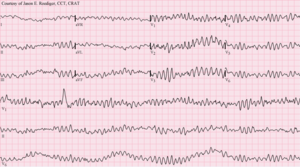Heart arrhythmia
| Cardiac arrhythmia | |
|---|---|
 |
|
| Ventricular fibrillation (VF) an example of a serious cardiac arrhythmia. | |
| Classification and external resources | |
| Specialty | Cardiology |
| ICD-10 | I47 – I49 |
| ICD-9-CM | 427 |
| DiseasesDB | 15206 |
| MedlinePlus | 001101 |
| MeSH | D001145 |
Cardiac arrhythmia, also known as cardiac dysrhythmia or irregular heartbeat, is a group of conditions in which the heartbeat is irregular, too fast, or too slow. A heart rate that is too fast – above 100 beats per minute in adults – is called tachycardia and a heart rate that is too slow – below 60 beats per minute – is called bradycardia. Many types of arrhythmia have no symptoms. When symptoms are present these may include palpitations or feeling a pause between heartbeats. More seriously there may be lightheadedness, passing out, shortness of breath, or chest pain. While most types of arrhythmia are not serious, some predispose a person to complications such as stroke or heart failure. Others may result in cardiac arrest.
There are four main types of arrhythmia: extra beats, supraventricular tachycardias, ventricular arrhythmias, and bradyarrhythmias. Extra beats include premature atrial contractions, premature ventricular contractions, and premature junctional contractions. Supraventricular tachycardias include atrial fibrillation, atrial flutter, and paroxysmal supraventricular tachycardia. Ventricular arrhythmias include ventricular fibrillation and ventricular tachycardia. Arrhythmias are due to problems with the electrical conduction system of the heart. Arrhythmias may occur in children; however, the normal range for the heart rate is different and depends on age. A number of tests can help with diagnosis including an electrocardiogram (ECG) and Holter monitor.
...
Wikipedia
